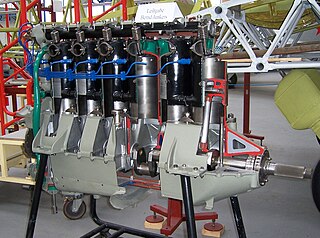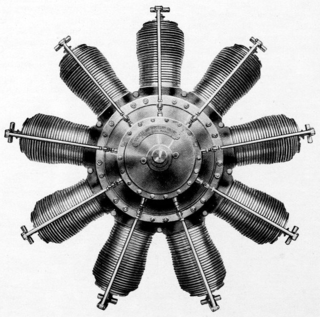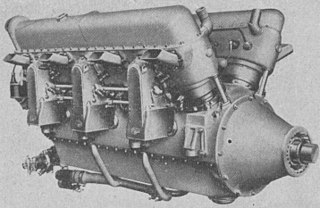
The Junkers L 5 was a six-cylinder, water-cooled, inline engine for aircraft built in Germany during the 1920s. First run in 1925, it was a much enlarged development of the Junkers L2, in turn a licensed development of the BMW IV.

The Anzani 10 was a 1913 10-cylinder air-cooled radial aircraft engine. It powered several experimental aircraft and also the later production versions of the Caudron G.3 reconnaissance aircraft, the Caudron G.4 bomber/trainer and the first production Cessna, the Model AA.

From 1905 to 1915, Alessandro Anzani built a number of three-cylinder fan and radial engines, one of which powered Louis Blériot's 1909 cross-channel flight. An Anzani three-cylinder engine that powers a Blériot XI based in England is thought to be the oldest airworthy engine in the world.

Alessandro Anzani developed the first two-row radial from his earlier 3- cylinder Y engine by merging two onto the same crankshaft with a common crankweb.

The Green D.4 was a four-cylinder watercooled inline piston engine produced by the Green Engine Co in the UK in 1909. It produced about 60 hp (45 kW) and played an important role in the development of British aviation before World War I.

The Gnome 9 Delta was a French designed, nine-cylinder, air-cooled rotary aero engine that was produced under license in Britain. Powering several World War I era aircraft types it produced 100 hp (75 kW) from its capacity of 16 litres (980 cu in).
One of Avia's own designs, the 1930s Avia Rk.12 was a seven-cylinder radial engine with a rated output of 150 kW (200 hp), built in Czechoslovakia.
The Lorraine 9N Algol was a French 9-cylinder radial aeroengine built and used in the 1930s. It was rated at up to 370 kW (500 hp), but more usually in the 220–300 kW (300–400 hp) range.

The Lorraine 12H Pétrel was a French V-12 supercharged, geared piston aeroengine initially rated at 370 kW (500 hp), but later developed to give 640 kW (860 hp). It powered a variety of mostly French aircraft in the mid-1930s, several on an experimental basis.

The Fiat A.22 was an Italian water-cooled aircraft engine from the 1920s. It produced 425 kW (570 hp) and powered several absolute world distance records as well as commercial passenger flights.

The Fiat A.25 was an Italian water-cooled aircraft engine from the 1920s. It produced 708 kW (950 hp) and was used by the Regia Aeronautica for fifteen years to power their Fiat BR.2 and BR.3 bombers.

The Fiat AN.1 was an experimental Italian water-cooled diesel straight six cylinder aircraft engine from the late 1920s.

The Lorraine 14A Antarès was a French 14-cylinder radial aero engine built and used in the 1930s. It was rated in the 370 kW (500 hp) range.

The Potez 6D is a French six cylinder inverted inline aircraft engine put into production after World War II in normal and supercharged versions. Unsupercharged, it produced a take-off power of 179 kW (240 hp) at 2,530 rpm.
The Potez 8D is the largest member of the Potez D series of air-cooled piston aircraft engines which share several common features. It is a supercharged eight cylinder inverted engine with a take-off power of 373 kW (500 hp).

The Renault 100 hp aircraft engine from 1912 was a twelve-cylinder, air cooled 60° vee engine built by the French Renault company.

The Renault 130hp V-12, aka Renault 138hp V-12 aircraft engine is a twelve-cylinder, air cooled 90° vee engine built by the French Renault company.

The De Dion-Bouton 78 hp, typically referred to as De Dion-Bouton 80 hp, was an eight-cylinder, air cooled vee aircraft engine that has been built by De Dion-Bouton.

The Rapp 200 hp was a water-cooled 90° V-8 aircraft engine built by Rapp Motorenwerke.

The Renault 50/60 hp aircraft engines were a series of air cooled 90° V-8 engines with a bore and stroke of 90 mm × 120 mm built by the French Renault company in the years from 1908 to about 1911.

















